The summer solstice is a perfect time for harvesting and preserving herbs! Here’s the complete guide to preserving the culinary and medicinal bounty of the herb garden.

(This post was contributed by Melissa Keyser.)
If I only had space to grow a few potted plants, those pots would be filled with herbs. Can you imagine a summer tomato salad without fresh basil, spaghetti sauce without oregano, or a winter roast without rosemary?
As an avid cook and a dabbling herbalist, I use assorted herbs, both fresh and dried, on a daily basis. My kitchen and home apothecary wouldn’t be complete without them! My guess is, you’re probably the same.
While many herbs are best enjoyed fresh, like cilantro in a salsa, most herbs are equally as useful when dried or otherwise preserved for future use. My California climate allows me to grow the woody herbs, like oregano and thyme, year-round, but I still take the time for drying herbs and using other preserving methods to have herbs on hand all year round.
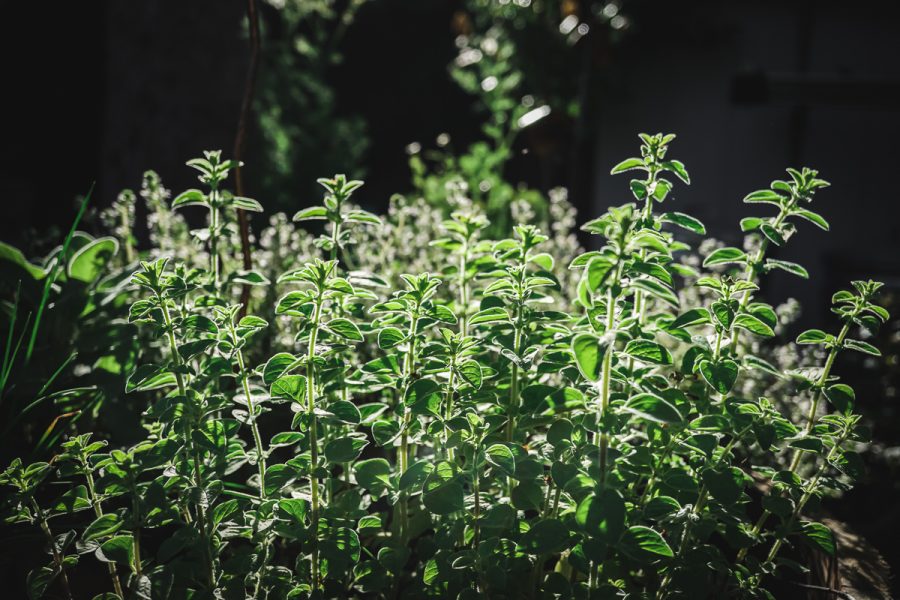
Summer Solstice is the Time for Herbs
Wise women say that the power of the sun on Solstice is the strongest, and is the ideal time to harvest herbs. This act recognizes the bounty of the sun god, who is a patron of healing and medicine. Coincidently, many culinary herbs also act as powerful healing herbs, making this the ideal time to harvest both culinary and medicinal herbs.
Herbs are best harvested before they start to bloom, when the plant is lush with new growth but energy hasn’t yet moved to produce flowers. I love the idea of using the Solstice as a natural timekeeper and a reminder to harvest herbs.
However, in my area, summer comes fast and I usually harvest in late spring. However, herbs season extends for many months, and I’ll be sure to pick a few branches to honor the day.
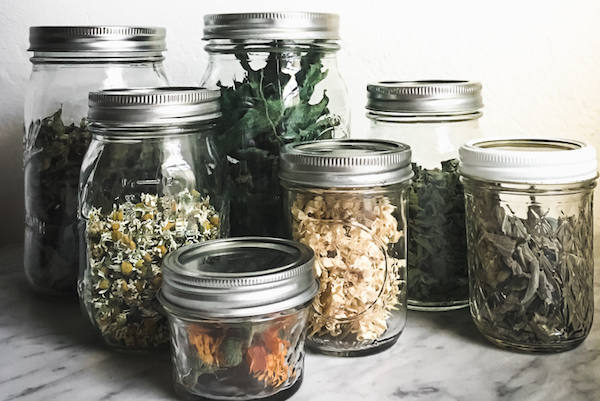
If you haven’t harvested and dried your herbs yet, the upcoming Summer Solstice is a perfect time to do so! Because on those dark and cold days of winter, what could be more magical than opening up a jar of dried herbs and releasing the aroma and flavors of summer?
There are several different ways to preserve your herb harvest, regardless if you harvest with the sun god in mind or not! Think about how you might want to savor that particular herbs flavor or healing properties in the future, and use a method of herb preserving that makes the most sense.
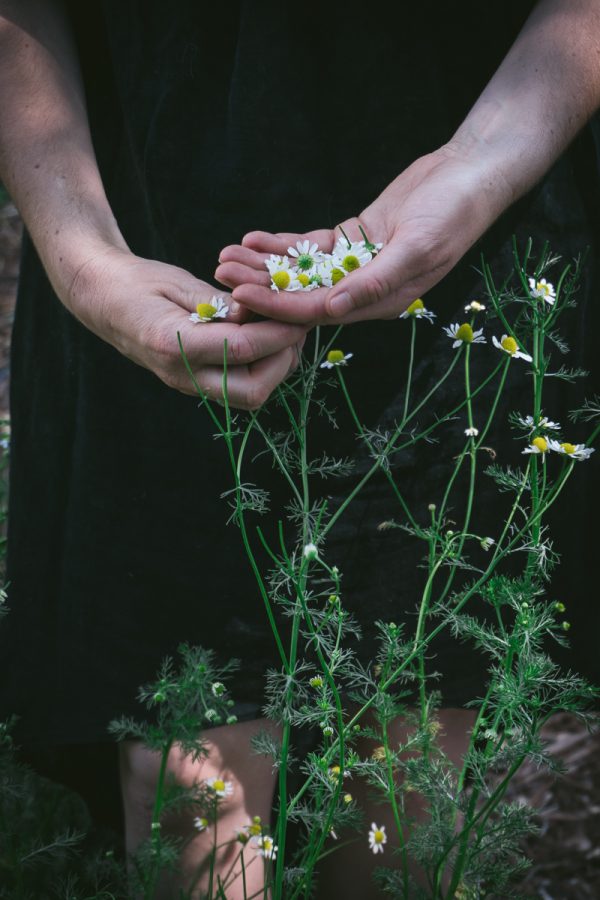
The Complete Guide to Preserving Herbs and Flowers
Drying Herbs:
This is the way I preserve almost all of my culinary herbs, as well as medicinal herbs or flowers for teas or other potions. I live in an area with dry heat, so air-drying is the easiest for me. You’ll know it’s herb season when I have bundles hanging from my pot rack and bowls and baskets scattered around flat surfaces!
Once herbs are dry, remove leaves from woody stems and store in a jar or container. Don’t forget to label, as dried green leaves can look very similar when you’re in the middle of cooking or brewing tea while half asleep (looking at you nettles and basil leaves).

Air-drying:
Bundle up sprigs of washed herbs with twine or string and hang upside down by their stems in an area with good circulation but out of direct sunlight.
Alternatively, which works well with flowers, you can lay out on tea towels, trays, screens, in colanders, or even bowls, and set to dry out of direct light. Sift through the herbs with your fingers daily to mix them up and promote even drying.
Oven:
Set the oven to 175° F, or the lowest temperature the oven will go, and lay your herbs out on a baking sheet in an even layer. Check every 30 minutes and bake until dry to the touch, but they should still be green (usually about an hour or more).
Dehydrator:
Place herbs in a single layer on dehydrator trays and dry at 95°F until crumbling.
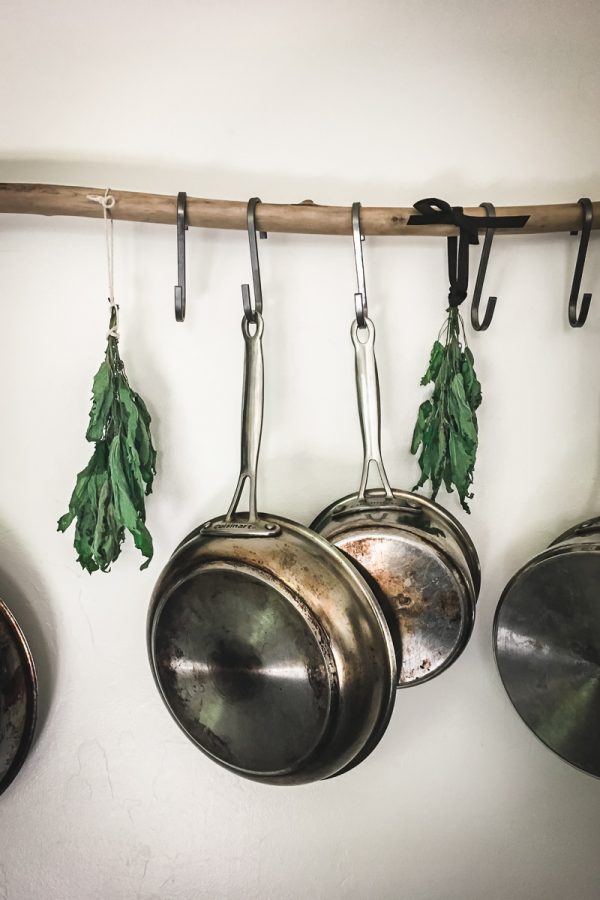
Frozen Herbs:
This is a great way to freeze herbs that will be added to soup or dishes with sauces. They may lose their texture and the color may change, but they retain most of their flavor or healing properties.
Finely chop fresh herbs and pack into an ice cube tray. Fill the tray with water, and freeze until solid.
Transfer the cubes into a bag or an airtight container, and toss a few cubes into your dish. I often use this method for basil, which I add to tomato soup.
Herbs blended up into pesto also freeze beautifully. I fill little 4 oz jars for the freezer and pull out as needed, but ice cube trays also work great for small portions. You might get some discoloration on basil pestos, but the taste is just as good when fresh.
I also freeze edible flowers in ice cube trays to add to drinks and ice tea!
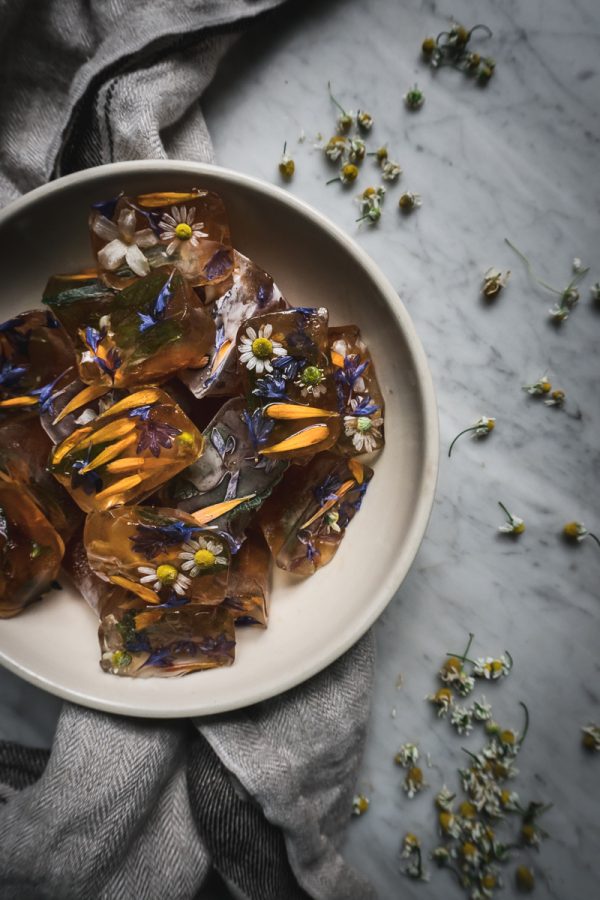
Preserving Herbs in Vinegar:
This way might not preserve the herb itself, but it infuses vinegar with the herb’s flavor or healing properties. You can use any type of vinegar, but wine vinegar is the most common for culinary and apple cider is used for medicinal.
Simply wash your herbs if necessary, place in a clean jar, and pour over with vinegar. Let the vinegar infuse for at least 3-4 weeks, then strain and discard the herbs (if desired- it will only get stronger over time), and rebottle the vinegar. Depending on your herbs, infused vinegar is great to use in salad dressing or taken as a shot like fire cider.
Preserving Herbs In Oil:
Like vinegar, this does not preserve the plant part, but it does save the flavor. This is a great way for oils that will be used in dishes where you want a subtle hint of that herb’s flavor.
Place clean and dried herbs in a jar, and top with oil, making sure herbs are completely submerged. Store in a cool and dark area, and let infuse for 4-6 weeks.
Important Note:
It’s important to note that herbs and oils are both low-acid. Together, they could support the growth of mold or botulism bacteria. The National Center for Home Food Preservation recommends that oils flavored with fresh herbs be stored in the refrigerator and used within 2 to 3 days.
I want my herbs to infuse for at least a month, so I personally only use dried herbs in oil. If you want to try infusing fresh herbs, you can also infuse your oils in the fridge.
Preserving Herbs In Honey:
It’s unlikely you’d want to smear oregano-infused honey on toast, but herbal honey can be great to add to tea or use in cooking. Thyme honey, in particular, is great for a gentle cough and cold remedy.
Floral-infused honey can add a subtle treat when spread on scones or drizzled on cheese. I recently made a jasmine honey and I have a chamomile honey planned. Infused honey with savory herbs is also great to use in dishes such as glazed roasted vegetables.
Fill a jar half full of fresh, but washed and dried, herbs (you don’t want water clinging to them), and pour over enough honey to cover the herbs. Let steep in a warm spot, such as a sunny windowsill, for at least 2 weeks. Strain if desired, or store in a cool area or the fridge.
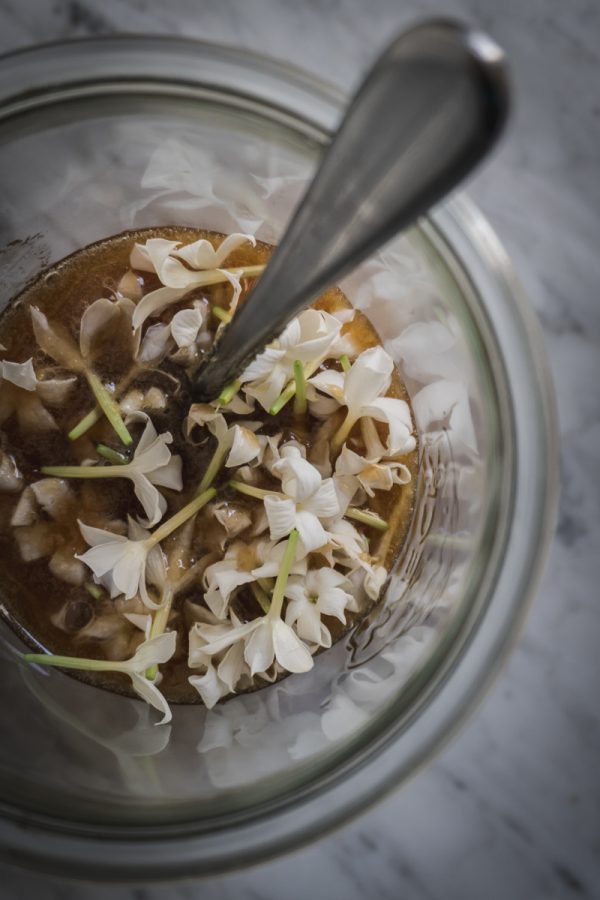
Preserving Herbs in Sugar or Salt:
I personally have not used salt or sugar as a method to preserve herbs. However, I always love tasting the flavored salts and sugars I see at my local boutique herbs store!
Place either chopped, whole leaves or sprigs, of fresh herbs in a jar with sugar or salt. Sugars infused with mint, lavender, or lemon balm would be delicious sprinkled on cookies.
Salts with thyme, rosemary or basil would be great in savory dishes such as sprinkled on meat or fish. You can use both sugar or salt and herbs in dishes.
Preserving Herbs in Alcohol (Tinctures)
Tinctures or extracts are herbs preserved in alcohol. Commonly taken by the dropper full, tinctures are potent medicinal remedies.
For pleasant-tasting herbs, a simple tincture can become a liqueur with the addition of a bit of simple syrup to taste. Liqueurs have the same medicinal properties and are a lovely way to take your medicine.
Herbal bitters are also a good option, and they’re made by extracting bitter digestive herbs in alcohol.
Here are a few common herbal tinctures:
Preserving Herbs as Oxymels
An oxymel is basically a herbal syrup made with honey and raw cider vinegar. Generally, oxymels are made by mixing equal parts herb, raw honey, and raw cider vinegar. The herb extracts in both the honey and the vinegar, creating a pleasant probiotic herbal syrup.
My favorite one to make at home is Elderberry Oxymel.
What do you think? How are you going to preserve your herbal harvest?
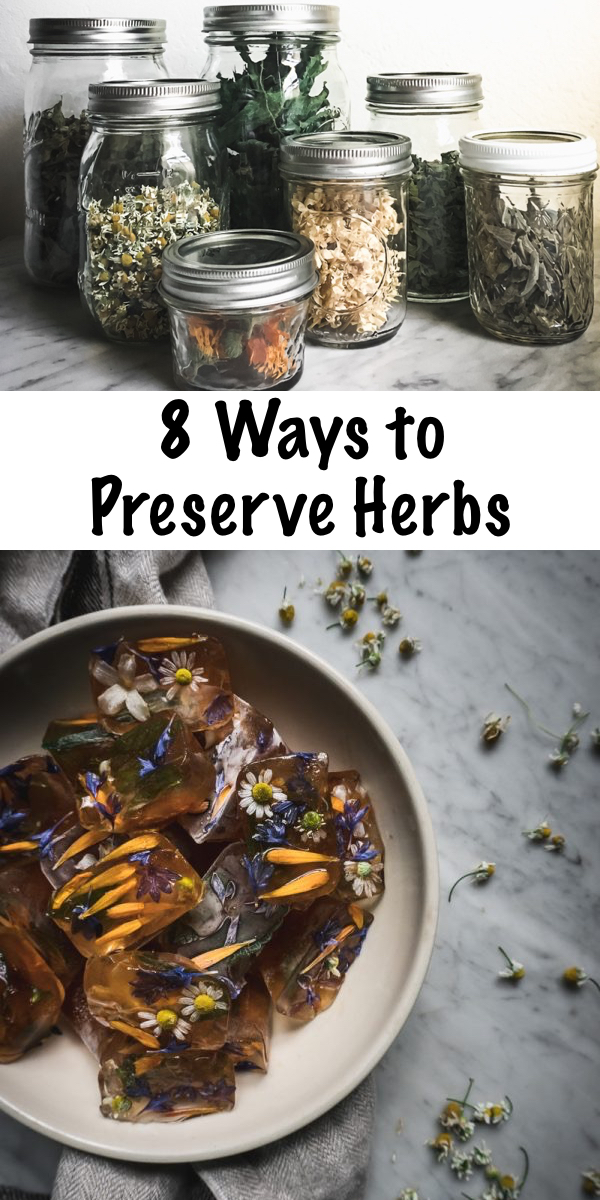
I’ve used many of these methods, including the salt! I make a Basil Salt that is delicious (I’ve got a post on my blog if you’d like to see it)
Another method you didn’t mention was making & freezing herb butter. I like to keep some garlic butter & parsley butter in the freezer to melt over steaks or toss w some vegetables.
Thanks for the info on vinegars/herbs. Have a lot of herbs this summer and trying to preserve them. Any thoughts on lemon balm?
Oh man, I love lemon balm! We mostly dry it, but this year we made lemon balm mead which I’m really excited about. I’ve got another article here on ways to use lemon balm that has links to ice cream and other preserved lemon balm recipes too.
My first time to visit your web site. Love all things you wrote and listed. My favor picture that the Mother Goat and babies. Your homestead is so beautiful nice quite ad comfortable. I wish have land like your. Thanks again for your recipes with dry herbs and teas. I will try them all.
Take care
God bless
Hi! Glad to find you! A friend just gave me a gallon of chamomile flowers! They’re almost past usage too so I’m creating preserves like crazy! You’ve inspired me to make a chamomile oxymel! Thank you! Perfect for a frazzled nervous system and tummy that is out of balance! Maybe I’ll add some ginger I dried recently!
That sounds amazing! I’ve never made oxymel with chamomile, but I bet it’d be lovely. I’d also suggest a chamomile mead! We were similarly gifted a huge quantity of chamomile flowers one year and made a 5 gallon batch of chamomile mead that was really amazing. We just pulled an 8-year-old bottle of it out of the basement this week and it’s amazing. If you try it, use this recipe for lemon balm mead but with about half the volume of fresh chamomile flowers.
The all new ball book of canning and preserving also has a recipe for roasted strawberry chamomile jelly that looks really amazing. I talk about how to make it as a variation in this recipe for strawberry jelly.
Great post! I love making herb salts, it’s one of my favorite ways to use my herbs. I also freeze, dry and make infused oil, vinegar and tincture but I’ve never infused honey. I’m definitely going to try that this year.
That’s great! Let us know how it goes for you.